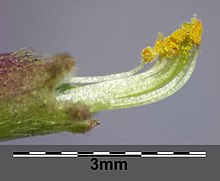Austria tragacanth
| Austria tragacanth | ||||||||||||
|---|---|---|---|---|---|---|---|---|---|---|---|---|

Austria tragacanth ( Astragalus austriacus ) |
||||||||||||
| Systematics | ||||||||||||
|
||||||||||||
| Scientific name | ||||||||||||
| Astragalus austriacus | ||||||||||||
| Jacq. |
The Austria tragacanth ( Astragalus austriacus ) is a type of plant from the legume family (Fabaceae). It is widespread from southwest Europe across Central Europe , Southeast Europe , Eastern Europe , Siberia and the Caucasus to Central Asia.
description
Vegetative characteristics
The Austria tragacanth grows as a perennial herbaceous plant and reaches heights of usually 20 to 30, sometimes up to 50 centimeters. The prostrate to ascending and upright-protruding branched stem is petiolate to square and leafy. Both stems and leaves are covered with compass needle hair.
The alternate leaves are unpaired with five to eleven pairs of pinnate leaflets and have distinct terminal leaflets . The leaflets are linear with a length of 5 to 15 millimeters. The stipules are free.
Generative characteristics
5 to 25 protruding to nodding flowers are grouped together in a loose, racemose inflorescence . The cover sheet is 0.5 to 1 millimeter long. The hermaphroditic, five-fold, zygomorphic flowers are 5 to 8 millimeters long. The calyx teeth are obtuse triangular and at most a quarter as long as the calyx tube. The five petals are light blue-purple to purple-purple. The wings are clearly outlined and have two columns.
The legume is pendulous.
Chromosome number
The number of chromosomes is 2n = 16.
ecology
The blooming time of this hemicryptophyte extends in Central Europe from May to June , sometimes to September .
Occurrence and endangerment
The distribution area of Austria tragacanth stretches from south-western Europe across Central Europe , South-Eastern Europe , Eastern Europe , Siberia and the Caucasus to Central Asia . In German-speaking countries, Austria tragacanth is only native to Austria .
In Austria, scattered occurrences are only known from the Pannonian area of the federal states of Vienna , Lower Austria and Burgenland . The Austria tragacanth prefers semi-arid grasslands in Austria and adjacent areas in the colline altitude range . In Austria the Austria tragacanth is considered endangered.
Individual evidence
- ↑ a b c d e f Manfred A. Fischer, Karl Oswald, Wolfgang Adler: Excursion flora for Austria, Liechtenstein and South Tyrol . 3rd, improved edition. Province of Upper Austria, Biology Center of the Upper Austrian State Museums, Linz 2008, ISBN 978-3-85474-187-9 , p. 586 .
- ^ Astragalus austriacus at Tropicos.org. In: IPCN Chromosome Reports . Missouri Botanical Garden, St. Louis
- ^ Astragalus austriacus in the Germplasm Resources Information Network (GRIN), USDA , ARS , National Genetic Resources Program. National Germplasm Resources Laboratory, Beltsville, Maryland.
- ↑ Distribution map at Euro + Med.
literature
- Manfred A. Fischer, Karl Oswald, Wolfgang Adler: Excursion flora for Austria, Liechtenstein and South Tyrol . 3rd, improved edition. Province of Upper Austria, Biology Center of the Upper Austrian State Museums, Linz 2008, ISBN 978-3-85474-187-9 , p. 586 .



